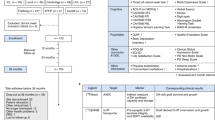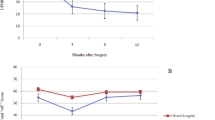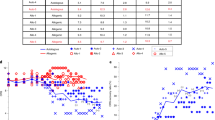Abstract
The movement disorder in Parkinson's disease results from the selective degeneration of a small group of dopaminergic neurons in the substantia nigra pars compacta region of the brain. A number of exploratory studies using human fetal tissue allografts have suggested that transplantation of dopaminergic neurons may become an effective treatment for patients with Parkinson's disease and the difficulty in obtaining human fetal tissue has generated interest in finding corresponding non-human donor cells. Here we report a post-mortem histological analysis of fetal pig neural cells that were placed unilaterally into the caudate-putamen brain region of a patient suffering from Parkinson's disease. Long-term (over seven months) graft survival was found and the presence of pig dopaminergic neurons and other pig neural and glial cells is documented. Pig neurons extended axons from the graft sites into the host brain. Furthermore, other graft derived cells were observed several millimeters from the implantation sites. Markers for human microglia and T-cells showed only low reactivity in direct proximity to the grafts. This is the first documentation of neural xenograft survival in the human brain and of appropriate growth of non-human dopaminergic neurons for a potential therapeutic response in Parkinson's disease.
This is a preview of subscription content, access via your institution
Access options
Subscribe to this journal
Receive 12 print issues and online access
$209.00 per year
only $17.42 per issue
Buy this article
- Purchase on Springer Link
- Instant access to full article PDF
Prices may be subject to local taxes which are calculated during checkout
Similar content being viewed by others
References
Hantraye, P., Riche, D., Maziere, M. & Isacson, O. Intrastriatal transplantation of cross-species fetal striatal Cells reduces abnormal movements in a primate model of Huntington disease. Proc. Natl. Acad. Sci. USA 89, 4187–4191 (1992).
Wictorin, K., Brundin, P., Gustavii, B., Lindvall, O. & Björklund, A. Reformation of long axon pathways in adult rat central nervous system by human forebrain neu-roblasts. Nature 347, 556–558 (1990).
Redmond, D.E. et al. Cryopreservation, culture, and transplantation of human fetal mesencephaiic tissue into monkeys. Science 242, 768–771 (1988).
Freeman, T.B. et al. Cross-species intracerebral grafting of embryonic swine dopaminergic neurons. Prog. Brain Res. 78, 473–477 (1988).
Huffaker, T.K. et al. Xenografting of fetal pig ventral mesencephalon corrects motor asymmetry in the rat model of Parkinson's disease. Brain Res. 77, 329–336 (1989
Isacson, O., Riche, D., Hantraye, P., Sofroniew, M. & Maziere, M. A primate model of Huntington's disease: Cross-species implantation of striatal precursor Cells to the excitotoxically lesioned baboon caudate-putamen. Exp. Brain Res. 75, 213–220 (1989).
Pakzaban, P. & Isacson, O. Neural xenotransplantation: Reconstruction of neuronal circuitry across species barriers. Neurosdence 62, 989–1001 (1994).
Isacson, O. et al. Transplanted xenogeneic neural Cells in neurodegenerative disease models exhibit remarkable axonal target specificity and distinct growth patterns of glial and axonal fibres. Nature Med. 1, 1189–1194 (1995).
Galpern, W.C., Burns, L.H., Deacon, T.W., Dinsmore, J. & Isacson, O. Xenotransplantation of porcine fetal ventral mesencephalon in a rat model of Parkinson's disease: Functional recovery and graft morphology. Exp. Neural. 140, 1–13 (1996).
Strömberg, I. et al. Human fetal mesencephaiic tissue grafted to dopamine-denervated striatum of athymic rats: Light-and electron-microscopical histochem-istry and in vivo chronoamperometric studies. J. Neurosd. 9, 614–624 (1989).
Lindvall, O. et al. Evidence for long-term survival and function of dopaminergic grafts in progressive Parkinson's disease. Ann. Neural. 35, 172–180 (1994).
Kordower, J.H. et al. Neuropathological evidence of graft survival and striatal rein-nervation after the transplantation of fetal mesencephaiic tissue in a patient with Parkinson's disease. New Engl. J. Med. 332, 1118–1124 (1995).
Freed, C. et al. Survival of implanted fetal dopamine Cells and neurologic improvement 12 to 24 months after transplantation for Parkinson's disease. N. Engl. J. Med. 327, 1549–1555 (1992).
Clarke, D.J. et al. Human fetal dopamine neurons grafted in a rat model of Parkinson's disease: Ultrastructural evidence for synapse formation using tyrosine hydroxylase immunocytochemistry. Exp. Brain Res. 73, 115–126 (1988).
Steele, D.J. & Auchincloss, H.J., Annu. Rev. Med. 46, 345–360 (1995).
Sachs, D.H. & Bach, F.H. Immunology of xenograft rejection. Hum. Immunol. 28, 245–251 (1990).
Hammer, C., Suckfull, M. & Saumweber, D. Evolutionary and immunological aspects of xenotransplantation. Transplant. Proc. 24, 2397–2400 (1992).
Pedersen, E.B., Poulson, F.R., Zimmer, J. & Finsen, B. Prevention of mouse-rat xenograft rejection by a combination therapy of cyclosporin A, prednisolone and azathioprine. Exp. Brain Res. 106, 181–186 (1995).
Pakzaban, P., Deacon, T.W., Burns, L.H., Dinsmore, J. & Isacson, O. A novel mode of immunoprotection of neural xenotransplants: masking of donor major histocompatibility complex class I enhances transplant survival in the CMS. Neurosdence 65, 983–996 (1995).
Bartlett, P.F. et al. Allograft rejection overcome by immunoselection of neural precursor Cells. Prog. Brain Res. 82, 153–160 (1990).
Honey, C.R., Charlton, H.M. & Wood, K.J. Rat brain xenografts reverse hypogonadism in mice immunosuppressed with anti-CD4 monoclonal antibody. Exp. Brain Res. 85, 149–152 (1991).
Honey, C.R., Clarke, D.J., Dallman, M.J. & Charlton, H.M. Human neural graft function in rats treated with anti-interleukin II receptor antibody. Neuroreport 1, 247–249 (1991).
Sanberg, P.R., Borlongan, C.V., Saporta, S. & Cameron, D.F., Testis-derived Sertoli cells survive and provide localized immunoprotection for xenografts in rat brain. Nature Biotechnol. 14, 1692–1695 (1996).
Pakkenberg, B., Moller, A., Gundersen, H.J., Mouritzen-Dam, A. & Pakkenberg, H. The absolute number of nerve Cells in substantia nigra in normal subjects and in patients with Parkinson's disease estimated with an unbiased stereological method. J. Neural. Neurosurg. Psychiat. 54, 30–33 (1991).
Abercrombie, A. Estimation of nuclear population from microtome sections. Anat. Rec. 94, 239–247 (1946).
Kordower, J.H. et al. Functional fetal nigral grafts in a patient with Parkinson's disease: Chemoanatomic, Ultrastructural, and metabolic studies. J. Camp. Neural. 370, 203–230 (1996).
Mott, J.L. et al. Effects of glial Cell line-derived neurotrophic factor on dopaminergic transplants to the 6-OHDA denervated striatum. Soc. Neurosd. Abs. 22, 1492 (1996).
Aubert, I., Ridet, J.-L. & Gage, F.H. Regeneration in the adult mammalian CNS: Guided by development. Curr. Opin. Neurobiol. 5, 625–635 (1995).
Sloan, D.J., Wood, M.J. & Charlton, H.M. The immune response to intracerebral neural grafts. Trends Neurosd. 14, 341–346 (1991).
Starzl, T.E. et al. Baboon-to-human liver transplantation. Lancet 341, 65–71 (1993).
Bailey, L.L., Nehlsen-Cannarella, S.L., Concepcion, W. & Jolley, W.B. Baboon-to-human cardiac xenotransplantation in a neonate. JAMA 254, 3321–3329 (1985).
Iidstad, S.T. Xenotransplantation for AIDS. Lancet 347, 761 (1996).
Groth, C.G. et al. Transplantation of porcine fetal pancreas to diabetic patients. Lancet 344, 1402–1404 (1994).
Author information
Authors and Affiliations
Rights and permissions
About this article
Cite this article
Deacon, T., Schumacher, J., Dinsmore, J. et al. Histological evidence of fetal pig neural cell survival after transplantation into a patient with Parkinson's disease. Nat Med 3, 350–353 (1997). https://doi.org/10.1038/nm0397-350
Received:
Accepted:
Issue Date:
DOI: https://doi.org/10.1038/nm0397-350
This article is cited by
-
Cell-therapy for Parkinson’s disease: a systematic review and meta-analysis
Journal of Translational Medicine (2023)
-
Restoring Function to Dopaminergic Neurons: Progress in the Development of Cell-Based Therapies for Parkinson’s Disease
CNS Drugs (2020)
-
Towards a Better Treatment Option for Parkinson’s Disease: A Review of Adult Neurogenesis
Neurochemical Research (2016)
-
Direct reprogramming of human fibroblasts into dopaminergic neuron-like cells
Cell Research (2012)



